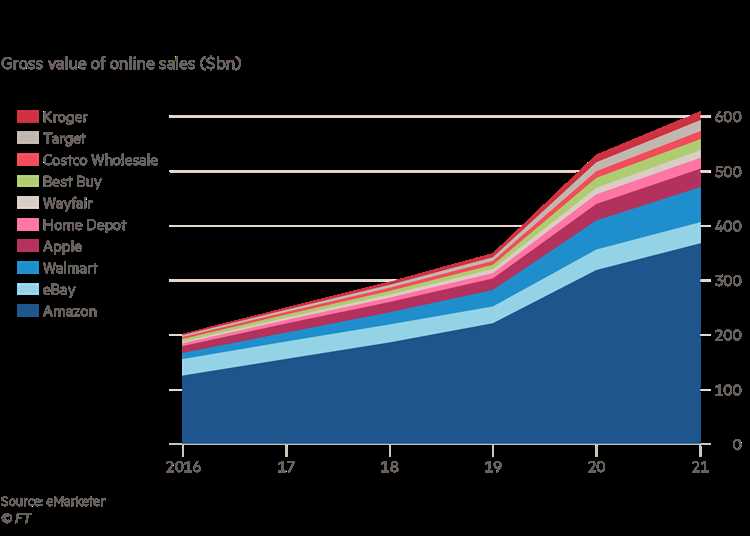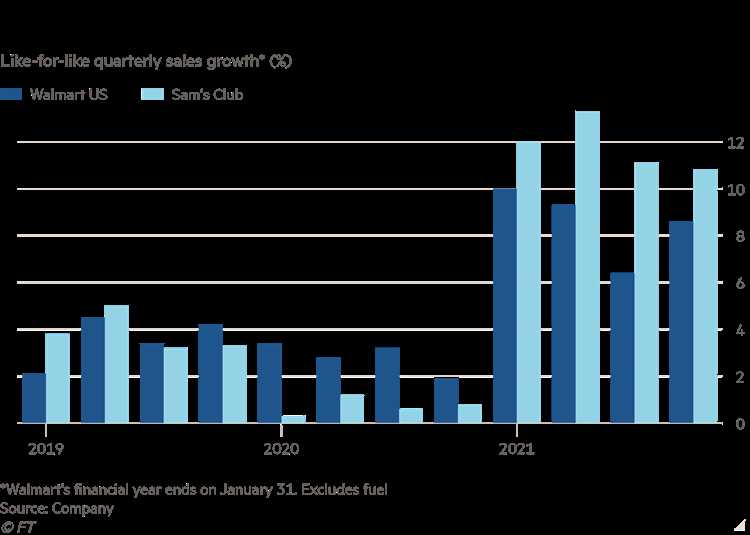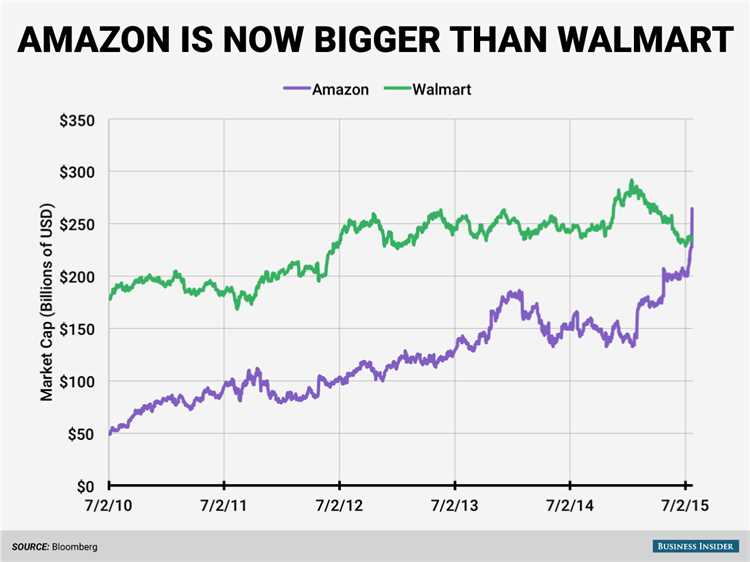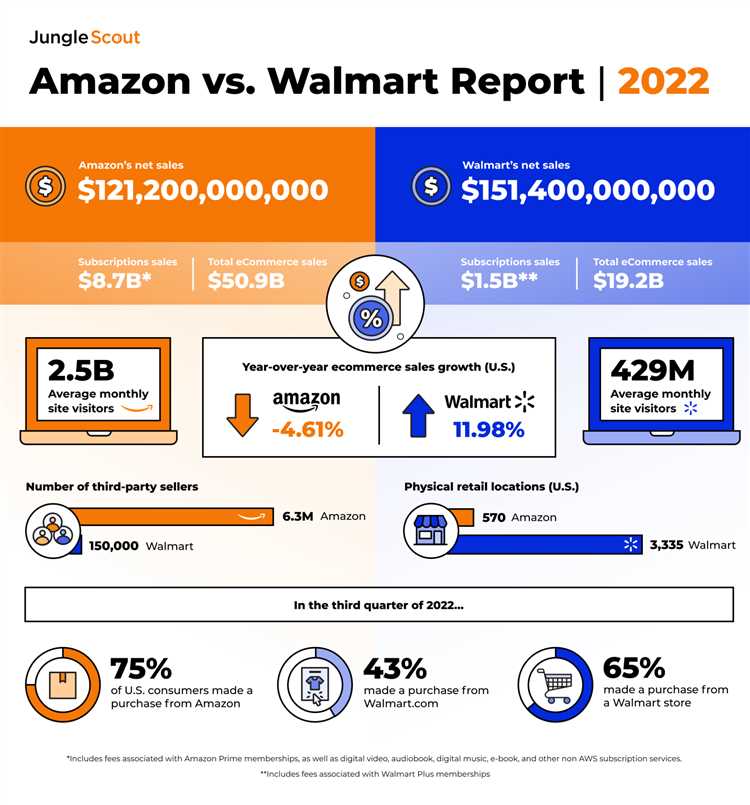
The e-commerce industry has witnessed a fierce competition between two retail giants, Walmart and Amazon. Both these companies have been vying for the top position in the online retail space, but the question remains: who truly reigns supreme?
Walmart, known for its brick-and-mortar stores, has made significant strides in expanding its e-commerce operations. With its extensive network of physical stores, the company has leveraged the power of omnichannel retailing, allowing customers to order items online and pick them up at their nearest Walmart store. This strategy has helped Walmart bridge the gap between online and offline shopping, appealing to a wide array of customers and making them a force to be reckoned with in the e-commerce industry.
On the other hand, Amazon has revolutionized the way people shop online. As one of the pioneers in e-commerce, Amazon has thrived on its vast selection of products, competitive pricing, and convenient delivery options. With their Prime membership program, Amazon has managed to retain a loyal customer base by offering perks like free two-day shipping, exclusive deals, and access to streaming services. They have also expanded their reach by venturing into various sectors, such as entertainment, cloud computing, and smart devices, solidifying their position as an e-commerce powerhouse.
While Walmart’s strong physical presence gives them an edge in terms of convenience and customer accessibility, Amazon’s innovation and relentless focus on customer satisfaction have catapulted them to the top of the e-commerce hierarchy. It’s important to note that both companies bring unique strengths and strategies to the table, catering to different customer needs and preferences.
Ultimately, the answer to who reigns supreme in the e-commerce battle between Walmart and Amazon is subjective and depends on various factors. While Walmart excels in providing a seamless blend of online and offline shopping, Amazon continues to dominate the e-commerce industry with its wide array of products, technological innovations, and customer-centric approach. Only time will tell who emerges as the true champion in this perpetual tug-of-war.
- The Rise of E-commerce
- Walmart’s E-commerce Expansion
- Investing in Online Infrastructure
- Strategic Acquisitions and Partnerships
- Amazon’s Dominance in E-commerce
- Amazon Prime: A Game-Changer
- Efficient Fulfillment and Customer Service
- Walmart: The Retail Giant
- Community Impact
- E-commerce Expansion
- Walmart’s E-commerce Strengths
- Walmart’s Challenges in the E-commerce Market
- 1. Catching up with Amazon’s logistics
- 2. Balancing online and offline presence
- Amazon: The E-commerce Pioneer
- Amazon’s E-commerce Successes
- 1. Wide Product Selection
- 2. Convenient Shopping Experience
- 3. Prime Membership Program
- 4. Innovation and Technology
- Question-answer:
- What is the significance of the e-commerce battle between Walmart and Amazon?
- How does Walmart’s e-commerce platform compare to Amazon’s?
- What are some key strategies employed by Walmart and Amazon in the e-commerce battle?
- How do Walmart and Amazon differentiate themselves in terms of pricing?
- What impact does the e-commerce battle between Walmart and Amazon have on smaller businesses?
- What is the main difference between Walmart and Amazon in terms of e-commerce?
The Rise of E-commerce
Over the past few decades, there has been a significant shift in the way consumers shop. With the advent of the internet, e-commerce has seen a tremendous rise in popularity. Online shopping has become a convenient and efficient way for people to purchase goods and services from the comfort of their own homes.
One of the main factors contributing to the rise of e-commerce is the development of technology. The internet has made it possible for businesses to establish an online presence, allowing them to reach a global audience. This has opened up new opportunities for retailers, enabling them to expand their customer base and increase sales.
Additionally, the rise of smartphones and mobile devices has also played a significant role in the growth of e-commerce. With the increasing prevalence of mobile internet, consumers can now shop on the go, anytime and anywhere. This convenience has made online shopping even more accessible and appealing to consumers.
Furthermore, the rise of e-commerce has also been fueled by the changing consumer behavior. Nowadays, customers value convenience and flexibility more than ever. With e-commerce, they can compare prices, read reviews, and make purchases with just a few clicks. This has revolutionized the way people shop, providing them with more options and control over their buying decisions.
Another driving force behind the rise of e-commerce is the availability of a wide range of products. Online retailers can offer a much larger selection of items compared to traditional brick-and-mortar stores. This vast inventory gives consumers access to products that may be hard to find locally, making e-commerce an attractive option for those looking for unique or specialized items.
In conclusion, e-commerce has experienced exponential growth in recent years, transforming the retail industry. The combination of technological advancements, changing consumer behavior, and a diverse range of products has propelled e-commerce to prominence. As more and more people embrace online shopping, it is clear that the rise of e-commerce is set to continue.
Walmart’s E-commerce Expansion

As the battle for e-commerce dominance continues, Walmart has been making significant efforts to expand its online presence and take on e-commerce giant Amazon.
Investing in Online Infrastructure
Walmart recognized the growing shift towards online shopping and has been investing heavily in building its e-commerce infrastructure. The company has been upgrading its website and mobile app to offer a seamless shopping experience to its customers. It has also been increasing its inventory and expanding its fulfillment centers to ensure faster and more efficient delivery.
Strategic Acquisitions and Partnerships
In an attempt to compete with Amazon’s wide range of product offerings, Walmart has been actively acquiring and partnering with e-commerce companies. Notably, it acquired Jet.com, an online retail startup, to bolster its e-commerce capabilities. Walmart has also been partnering with various digital marketplaces and technology firms to expand its reach and offer a wider range of products to its customers.
This expansion strategy has allowed Walmart to tap into new customer segments and attract younger, tech-savvy shoppers who prefer online shopping. By partnering with established e-commerce players and leveraging their expertise, Walmart has been able to quickly establish a stronger foothold in the e-commerce market.
Enhanced Online Grocery Shopping
Walmart has recognized the increasing demand for online grocery shopping and has invested heavily in enhancing its online grocery services. It has expanded its grocery delivery and pickup options, allowing customers to conveniently shop for groceries online and have them delivered to their doorstep or pick them up from a nearby store.
Conclusion
Walmart’s aggressive e-commerce expansion efforts have positioned it as a formidable competitor to Amazon. Its investments in infrastructure, strategic acquisitions, and partnerships, along with its focus on enhancing online grocery shopping, have allowed Walmart to effectively challenge Amazon’s e-commerce dominance. As the battle between the two retail giants continues, it will be interesting to see how Walmart further expands its e-commerce offerings and narrows the gap with Amazon.
Amazon’s Dominance in E-commerce
When it comes to e-commerce, Amazon is undoubtedly the reigning champion. Founded in 1994, this online marketplace has revolutionized the way people shop, making it incredibly convenient to find and purchase products from the comfort of their own homes.
One of the key factors contributing to Amazon’s dominance is its vast product selection. With millions of products available, customers can find almost anything they need on the platform. From electronics and clothing to household essentials and even groceries, Amazon has become a one-stop shop for many consumers.
In addition to its extensive product range, Amazon offers competitive pricing. The company’s ability to negotiate deals with suppliers and leverage economies of scale allows it to offer lower prices compared to many other retailers. This has made Amazon an attractive option for price-conscious shoppers.
Amazon Prime: A Game-Changer
Another factor that has contributed to Amazon’s dominance is its subscription service, Amazon Prime. For a fixed annual fee, Prime members enjoy benefits such as free two-day shipping, access to exclusive deals, and streaming of movies, music, and TV shows. This membership program has created a loyal customer base and further incentivized people to shop on Amazon.
Efficient Fulfillment and Customer Service
Amazon’s efficient fulfillment network is another key aspect of its dominance in e-commerce. The company has made significant investments in warehouses, logistics, and technology to ensure fast and reliable delivery. In addition, Amazon’s customer service is known for being responsive and resolving issues promptly, enhancing the overall shopping experience for its customers.
Overall, Amazon’s dominance in e-commerce is the result of its expansive product selection, competitive pricing, the success of its Prime membership program, and its efficient fulfillment network. As the company continues to innovate and expand its reach, it will likely maintain its position as the leader in online retail for the foreseeable future.
Walmart: The Retail Giant
When it comes to retail, few names hold as much weight as Walmart. With more than 11,000 stores in 27 countries, this retail giant has a massive presence in the industry. Founded in 1962 by Sam Walton, Walmart has grown from a single store in Arkansas to become one of the largest companies in the world.
One of Walmart’s key strengths is its ability to offer a wide range of products at competitive prices. From groceries and household essentials to electronics and clothing, Walmart has something for everyone. Its vast supply chain and global sourcing network allow it to keep costs low and pass the savings on to its customers.
Walmart is also known for its dedication to customer service. With its “Everyday Low Prices” slogan, the company strives to provide affordable options for its customers. It offers various services, such as online grocery pickup and delivery, to make shopping more convenient for its customers.
Community Impact
Walmart’s operations have a significant impact on the communities it serves. The retailer is often one of the largest employers in the areas where its stores are located, providing job opportunities for thousands of people. Additionally, Walmart is involved in various philanthropic initiatives, supporting education, disaster relief, and sustainability efforts.
E-commerce Expansion
In recent years, Walmart has been intensifying its efforts to compete with e-commerce giants like Amazon. The company has made significant investments in its online platform, expanding its product offerings and improving its website and mobile app. With initiatives like free two-day shipping and a seamless omnichannel experience, Walmart aims to provide a strong alternative to Amazon for online shoppers.
In conclusion, Walmart’s dominance as a retail giant is hard to ignore. With its wide range of products, competitive prices, and commitment to customer service, Walmart has solidified its position in the industry. As the company continues to invest in its e-commerce capabilities, it will be interesting to see how it fares in the ongoing battle with Amazon.
Walmart’s E-commerce Strengths
Walmart, as one of the world’s largest retailers, has made significant strides in the e-commerce industry. The company’s strengths in e-commerce are evident in several key areas:
1. Wide Range of Products: Walmart offers a vast selection of products in various categories, including electronics, home goods, clothing, and groceries. This extensive product range gives customers numerous options and increases the likelihood of finding what they need on the Walmart website.
2. Competitive Pricing: Walmart has a reputation for offering competitive prices on its products. The company leverages its massive buying power to negotiate lower prices with suppliers and pass the savings on to customers. This pricing advantage attracts price-conscious consumers who are looking for the best deal online.
3. Brick-and-Mortar Presence: Unlike its rival Amazon, Walmart has a significant physical store presence. This presence allows customers to pick up online orders in-store, saving on shipping costs and providing a faster delivery option. Walmart’s vast network of stores also serves as distribution centers, enabling fast delivery to customers’ homes.
4. Fulfillment Capabilities: Walmart has invested heavily in its e-commerce fulfillment capabilities, including the development of automated warehouses and a robust logistics network. These investments enable Walmart to efficiently fulfill and deliver online orders, ensuring a smooth and reliable shopping experience for customers.
5. Customer Loyalty Program: Walmart’s customer loyalty program, Walmart+ (formerly known as Walmart’s Delivery Unlimited), offers subscribers free shipping on orders over a certain amount, as well as other benefits like fuel discounts and access to exclusive deals. This program helps to build customer loyalty and encourages repeat purchases on the Walmart website.
6. Integration with Physical Stores: Walmart has integrated its e-commerce operations with its physical stores, allowing customers to return online purchases at any Walmart location. This integration provides added convenience and flexibility for customers, making the online shopping experience more seamless.
In conclusion, Walmart’s e-commerce strengths lie in its wide product range, competitive pricing, brick-and-mortar presence, fulfillment capabilities, customer loyalty program, and integration with physical stores. These strengths contribute to Walmart’s success in the e-commerce battle with Amazon and position the company as a strong contender in the online retail industry.
Walmart’s Challenges in the E-commerce Market
As one of the largest brick-and-mortar retailers in the world, Walmart has faced a series of challenges in the e-commerce market. While the company has made significant strides in expanding its online presence and enhancing its digital capabilities, it still lags behind its biggest rival, Amazon, in terms of e-commerce dominance.
1. Catching up with Amazon’s logistics
Walmart has been investing heavily in its supply chain and fulfillment infrastructure to compete with Amazon’s seamless logistics operations. However, bridging the gap between its extensive physical network and its online capabilities remains a major challenge for Walmart. Amazon’s efficient delivery network and quick turnaround times have set a high bar for customer expectations, putting pressure on Walmart to improve its last-mile delivery and overall fulfillment capabilities.
2. Balancing online and offline presence
Walmart’s traditional brick-and-mortar stores have been a significant advantage for the company, providing a vast physical footprint and a trusted brand presence. However, balancing its online and offline channels and creating a truly integrated omnichannel experience has proven challenging for Walmart. The company has struggled to effectively leverage its stores for click-and-collect and in-store return options, creating a seamless shopping experience for customers across all touchpoints.
In addition, managing pricing strategies and competing with Amazon’s aggressive online pricing has been a constant challenge for Walmart. The e-commerce market is known for its fierce price competition, and Walmart has had to continuously reassess its pricing strategy to stay competitive while maintaining profitability.
While Walmart has made significant investments in its e-commerce capabilities and continues to innovate in this space, overcoming these challenges will be critical for Walmart to assert its dominance in the e-commerce market and catch up with Amazon’s unparalleled success.
Amazon: The E-commerce Pioneer
When it comes to the e-commerce industry, Amazon is undoubtedly the pioneer. Founded by Jeff Bezos in 1994, Amazon started as an online bookstore and quickly expanded its offerings to include various other products and services.
What sets Amazon apart from its competitors is its relentless focus on customer satisfaction. The company revolutionized the e-commerce industry by introducing the concept of one-click shopping, which made the online shopping experience seamless and convenient for customers.
In addition to its user-friendly interface, Amazon also offers a wide range of products, from books and electronics to home goods and even groceries. With its vast selection of goods, competitive pricing, and fast shipping options, Amazon has become the go-to destination for online shoppers around the world.
Furthermore, Amazon’s investment in technology and innovation has allowed it to stay ahead of the curve. The company introduced Kindle, its own e-reader, which revolutionized the publishing industry. Amazon also pioneered the concept of cloud computing with Amazon Web Services (AWS), providing businesses with scalable and cost-effective IT solutions.
Today, Amazon continues to dominate the e-commerce landscape. It has expanded its reach globally and offers services beyond just retail, including streaming services like Amazon Prime Video and Amazon Music. The company’s commitment to customer satisfaction and constant innovation has solidified its position as the undisputed leader in the e-commerce industry.
Amazon’s E-commerce Successes

Amazon, the world’s largest online retailer, has been dominating the e-commerce industry for years. Their success can be attributed to several key factors.
1. Wide Product Selection
One of the biggest advantages Amazon has over its competitors is its extensive product range. With millions of products available, customers can find almost anything they need on the platform, from electronics to home goods to clothing and more. Amazon’s ability to offer such a wide selection is a major factor in their e-commerce success.
2. Convenient Shopping Experience
Amazon has perfected the art of delivering a convenient shopping experience to its customers. With features such as one-click purchasing, fast and reliable shipping options, and hassle-free returns, shopping on Amazon is a seamless and stress-free experience. This focus on convenience has helped Amazon attract and retain millions of loyal customers.
3. Prime Membership Program

Amazon’s Prime membership program has been a game-changer for the company. Offering perks such as free two-day shipping, access to streaming services, and exclusive deals, Prime has become a must-have for many online shoppers. By incentivizing customers to become Prime members, Amazon has created a dedicated and recurring revenue stream.
4. Innovation and Technology
Amazon is known for being at the forefront of innovation and technology in the e-commerce industry. From introducing voice-activated shopping with Alexa to investing in drone delivery, Amazon is constantly pushing boundaries and finding new ways to enhance the customer experience. Their commitment to innovation sets them apart from their competitors.
Overall, Amazon’s e-commerce success can be attributed to their wide product selection, convenient shopping experience, Prime membership program, and focus on innovation and technology. As they continue to evolve and adapt to the ever-changing e-commerce landscape, it’s clear that Amazon will remain a dominant force in the industry.
| E-commerce Success Factors | Amazon | Walmart |
|---|---|---|
| Wide Product Selection | ✓ | ✓ |
| Convenient Shopping Experience | ✓ | ✓ |
| Prime Membership Program | ✓ | |
| Innovation and Technology | ✓ |
Question-answer:
What is the significance of the e-commerce battle between Walmart and Amazon?
The e-commerce battle between Walmart and Amazon is significant because it showcases the competition between two retail giants for dominance in the online shopping market. Both companies have a huge customer base and are constantly innovating to offer better services, lower prices, and faster delivery options. This battle ultimately benefits consumers by driving innovation and providing more choices.
How does Walmart’s e-commerce platform compare to Amazon’s?
Walmart’s e-commerce platform has made significant improvements in recent years, but it still lags behind Amazon. While Walmart has seen steady growth and has expanded its online offerings, Amazon remains the industry leader with its vast selection of products, strong logistics network, and extensive Prime membership benefits. However, Walmart’s physical stores give it an advantage in terms of click-and-collect delivery options and potentially faster delivery speeds.
What are some key strategies employed by Walmart and Amazon in the e-commerce battle?
Both Walmart and Amazon employ various strategies in the e-commerce battle. Walmart has focused on leveraging its physical stores to offer click-and-collect delivery options, as well as same-day and next-day delivery in certain areas. They have also partnered with various e-commerce companies and acquired online brands to expand their product offerings. Amazon, on the other hand, has prioritized convenience and customer loyalty through programs like Prime, which offers fast and free shipping along with a range of additional benefits.
How do Walmart and Amazon differentiate themselves in terms of pricing?
Walmart and Amazon have different pricing strategies. Walmart is known for its “everyday low prices” and focuses on offering competitive prices across a wide range of products. They also have a price matching policy to ensure customers get the best deal. Amazon, on the other hand, utilizes dynamic pricing, which means their prices can fluctuate based on factors like demand and inventory levels. While Amazon may not always have the lowest prices, their pricing strategy is designed to offer competitive prices while still maximizing profits.
What impact does the e-commerce battle between Walmart and Amazon have on smaller businesses?
The e-commerce battle between Walmart and Amazon can have both positive and negative impacts on smaller businesses. On one hand, smaller businesses can benefit from the increased online shopping trend and reach a larger customer base through platforms like Walmart Marketplace and Amazon Marketplace. However, they must also compete with Walmart and Amazon’s own brands and face challenges in terms of visibility and competing on price. Overall, smaller businesses have to adapt and find ways to differentiate themselves to thrive in this competitive landscape.
What is the main difference between Walmart and Amazon in terms of e-commerce?
Walmart and Amazon differ in their business models and approach to e-commerce. While Walmart is primarily a brick-and-mortar retailer that has expanded into online sales, Amazon started as an online-only marketplace. This difference in their origins has influenced their strategies and offerings in the e-commerce space.